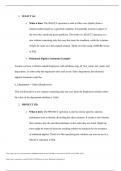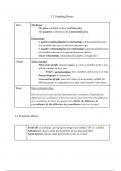Basic Concepts of Adult Development – Chapter 1
Adult Development and Ageing in a changing world
Sub-stages of adulthood
Because adulthood could easily stretch over 50 years, it is characterised by continuing changes in
basically all areas of functioning. It was therefore decided to divide adulthood into sub-stages,
namely:
Early adulthood (ages 20-39)
Middle Adulthood (ages 40-59)
Late Adulthood (ages 60 to death)
Although the above classification is widely used, psychologists have been unanimous in their
viewpoint that these categories should not be used too rigidly, because age is a relative concept and
it can be defined from different perspectives.
Defining Old Age in Africa
The age group 50-59 is traditionally defined in African culture as being those who are elderly, who are in a process of
preparing for the transition to old age.
This is thought of as the beginning of a period of reduced productive activity and the completion of reproductive activity,
including the care and education of the next generation and the consumption of accumulated savings.
In most African societies, the title “older person” is dictated by one’s role in society, such as becoming a grandparent. Such
titles are conferred regardless of chronological age.
Recently, the World Health Organisation used the cut-off point of 50 to define people in Africa as old, rather than the
frequently used cut-off of 60 in Western societies. The argument for using this definition is that in most poor economies the
burden of sheer survival puts people at a greater disadvantage that rich countries, leading them to age prematurely. In this
sense, this period is regarded as a period of high vulnerability in which negative events can undermine the prospects of
successful ageing.
Perspectives on age
Chronological Age
- Indicates the number of years that have passed since the person’s birth.
- Widely used as a measure in psychological research, but most developmental
psychologists agree that it is a criterion that has little meaning in itself.
- While there is a correlation between the time that has passed and these factors, it does
not mean that time causes developmental changes.
- What is important, is the extent to which development has taken place during the
chronological lifespan.
- Developmental changes can vary significantly among individuals of the same
chronological age.
- The rate of development can differ from one developmental area to another in the same
individual, e.g., the young adult who is intellectually mature but emotionally immature.
- The influence of cultural factors to determine a person’s age. (E.g. legally childhood is up
until 18, but some cultures initiate children at the age of 13 into adulthood).
, Psychological Age
Refers to the ability of the person to adjust to the environment and to cope with the associated
challenges, as compared to individuals of the same age. (40 year old living with his mom is much
younger psychologically than his peers).
Social Age
- The degree to which the person’s role in a society meets the expectations and
perceptions of that society.
- These expectations are strongly influenced by the norms and expectancies of the specific
society, which in turn are, to a large extent, dictated by factors such as culture, gender,
race and ethnicity.
- Social Age could also be regarded as a synonym for cultural age, especially when the
above-mentioned expectations have to meet specific culturally determined criteria, such
as having undergone an initiation ceremony.
Biological Age
This is the physical condition of a person, in comparison with her or his peer group. Relativity
also applies to this factor: E.g. a health conscious 50-year old man can be in a significantly better
physical condition than a 30-year-old who neglects his health.
Psychological age, social age and biological age are often used as a unit to determine the
individual’s functional age (The total ability of an individual to function effectively in his or her
environment).
Gerontologists often distinguish between primary, secondary and tertiary ageing.
Primary Ageing: Typical ageing, especially physical deterioration. It is universal, inevitable
and caused by inborn biological factors.
Secondary Ageing: Physical deterioration accelerated by disease or external factors such as
stress or an unhealthy lifestyle. It is not a universal part of the ageing process and is often
preventable.
Tertiary Ageing: The process of terminal decline that occurs in the time (months, weeks or
days) before death. It is characterised by a significant increase of physical and cognitive
deterioration in a relatively short period after which the individual dies. It is not related to
age, but signifies the approach of death.
The relativity and subjectivity of age have also led to the coining of two concepts:
Personal Age: How a person perceives and experiences his or her own age. Most adults feel
younger than their actual age.
The Ageless Self: The experience by adults that the “self” (the core of the personality)
remains the same regardless of biological and chronological ageing.
Gender Differences in the experience of age:
Women tend to be more anxious about growing old and experience themselves as “old”
than is the case with men.
Most societies place a much higher value on women’s physical appearance and reproductive
abilities than they do on men.
, Women feel more competent and confident in their 40s than they feel in their 30s.
Regardless of how psychologists define adulthood or how it is perceived by the individual, it should
always be taken into account that all such definitions are subjected to the legislation of the country.
The legal definition will always be the determining criterion. In South Africa the limit for legal
maturity is 18 years. (Changed from 21 to 18 in 2007 to be in line with international trend).
No area or topic can be studied without interpreting it in its context. Demographic context provides
an important informative background to the study of adulthood and development.
A lifespan developmental perspective
Paul Baltes, a leader in the study of life-span developmental psychology, identified the following key
principles which also provide the framework from which to study adult development:
Development is a lifelong process.
Human development takes place over the entire life-span and all age groups are equally important.
At every age, various developmental processes are at work and each period has its own
characteristics and own value. As can be expected, not all developmental processes are present at
birth.
Development is a multidimensional and multidirectional.
Development occurs in various dimensions and affects multiple aspects simultaneously. E.g.
Personality, cognitions and social functioning can all be changing at the same time, since any area of
development is intricately tied to other areas of development. However, development can also
occur in different directions: we may improve in some areas, remain stable in others, and decline in
still others.
Development is a combination of gains and losses.
Developmental processes increase and decrease throughout the life-span, since we both grow and
decline. As people lose in one area (e.g. processing speed) they may gain in another (e.g. wisdom).
People tend to maximise gains. They also minimise losses by learning to manage or compensate for
them.
Development shows plasticity.
Many aspects of development can be modified or altered: at any point a person’s experiences could
change their course of development. E.g. young people entering adulthood with substance-abuse
problems can overcome them and become responsible, successful adults. In addition, many abilities
such as memory, strength and endurance can be significantly improved with training and practice,
even late in life. Development is therefore not cast in stone; nevertheless, the potential for change
does have limits.
Development is embedded in history and context.
Development occurs within a given cultural-historical context. Individuals not only respond to their
social-cultural environments, but also interact with and actively influence them. E.g. those who grew
up in Apartheid have different factors influencing their development and will respond differently to
those growing up in the post-apartheid era.
Development occurs in context.
A person’s development is influenced by an interaction among many influences such as biological,
social or environmental influences. Some of these influences are similarly experienced by other
individuals, such as age-related changes, others we share because of similar times we live in, such as
, historical and social changes, while still others are uniquely experienced influences not shared by
others, such as unexpected events. How we develop over the years is therefore shaped by a variety
of influences, the total context of who we are and where we are in time.
Development is multidisciplinary.
Development is influenced by multiple factors. No single perspective can therefore adequately
explain the complexities of development. Many disciplines play a role in conceptualising and
influencing development. For example, the biological (medical) fields address the ageing process at
the organismic, molecular, cellular and neurological levels; psychology address adult development
and ageing from the socio-emotional, personality and cognitive domains, while sociology examines
demographical and social structural forces such as the impact of socio-economic factors, social
changes and political and social policies.
The forces and influences of development
Different forces shape development:
Biological Forces
These forces include all physical and physiologically related factors that affect development, such as
changes in physical appearance (wrinkles, grey hair), changes in organ and perceptual systems, body
mass, muscle tone and menopause, as well as health-related factors.
Psychological Forces
These include cognitive, emotional and personality factors that affect development. Collectively,
these are the characteristics that we notice about people as unique individuals. Some of these
characteristics may undergo some changes (either growth or decline) during the ageing process,
while others may remain stable.
Sociocultural Forces
These refer to interpersonal, societal and cultural forces which provide the overall contexts in which
we develop.
Life-cycle Forces
These are forces that affect the course of development and may be a combination of biological,
psychological and sociocultural forces that affect people in different points of their lives. These
forces may have either positive or negative effects on the individual’s development.
All of the above forces are interrelated and combine to influence people’s development. Paul Baltes
and his colleagues identified the following sets of influences that could affect development:
Normative age-graded influences
Experiences caused by biological, psychological and sociocultural forces and are usually associated
with chronological age.
Biological forces during adulthood include menopause, which signifies the end of the childbearing
period, and age related impairments in vision, hearing and reaction speed.
Psychological forces include adjustments in family life such as the responsibility of socialising the
next generation and adjusting to the ‘empty nest’ when children start leaving home, adjusting to
retirement and to the loss of a spouse.
Sociocultural forces include the time of first marriage and the birth of the first child, establishing a
career and ending a career through retirement.










